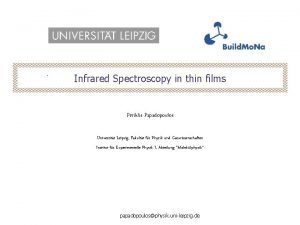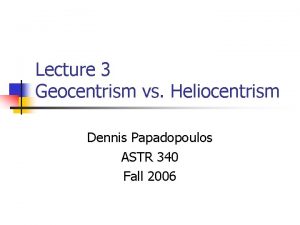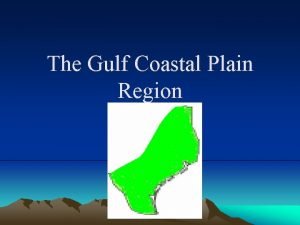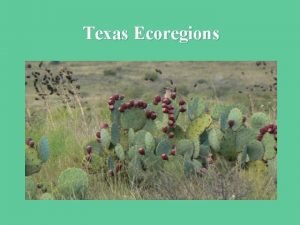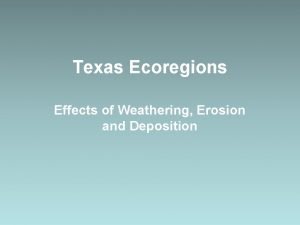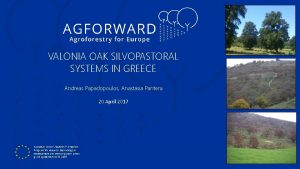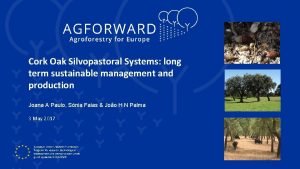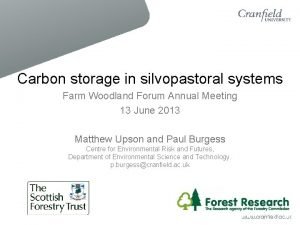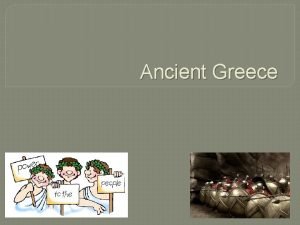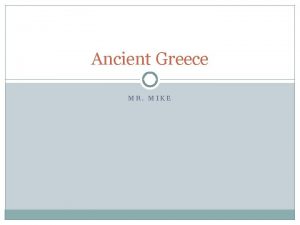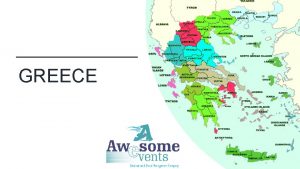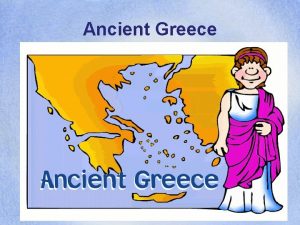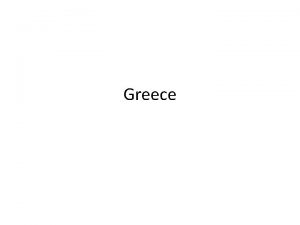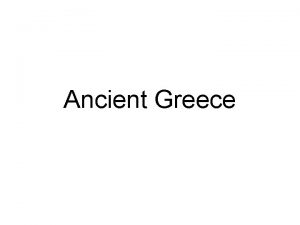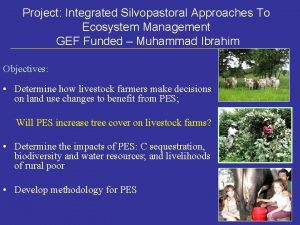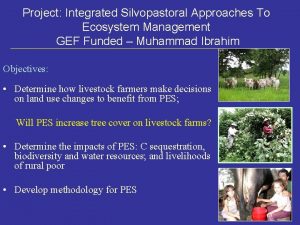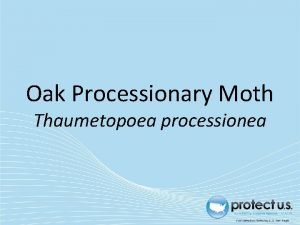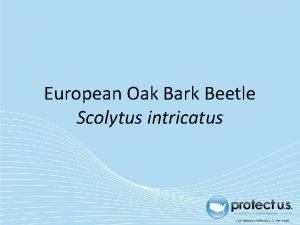VALONIA OAK SILVOPASTORAL SYSTEMS IN GREECE Andreas Papadopoulos



















- Slides: 19

VALONIA OAK SILVOPASTORAL SYSTEMS IN GREECE Andreas Papadopoulos, Anastasia Pantera 20 April 2017 European Union’s Seventh Framework Program for research, technological development and demonstration under grant agreement no 61 3520

Description of the system Objective 1: Description of valonia oak (Q. ithaburensis subsp. macrolepis) systems in Greece Objective 2: Description and innovation in Xeromero silvopastoral system Objective 3: Description and innovation in Kea Island agrosilvopastoral system Xeromero forest – W. Greece Island of Kea

Description of the system Area of valonia oak systems in Greece 29, 632 ha (stands, thickets, groups) characterised as traditional silvopastoral systems combining forest and livestock production. Farmland or abandoned arable fields containing valonia oak trees characterised as traditional agrosilvopastoral systems combining agricultural, forest and livestock production. (Pantera et al. 2008)

Description of the system Site characteristics and ownership Valonia oak systems found in plain, hilly and semimountainous areas up to 600 -700 m, on various rock and soil types and in different layers of vegetation and bioclimatic types. The 75% is public and community owned and 25% is private or claimed by individuals.

Description of the system Structure Generally, 3 vegetation layers. Tree layer consists mainly of valonia oak with ground cover of 0. 4 -0. 5 and density of 50 -60 trees ha-1 , on average. Middle layer consists of shrub species often with Phlomis fruticosa L. being dominant due to overgrazing. Understorey is rich in species and includes grasses, particularly annual, legumes and many broad-leaved herbs including fistulosus and Drimia maritima. Asphodelus

Description of the system Histor y Well known since ancient times for their use for: grazing, acorn cups harvesting and wood production for shipbuilding. Acorn cups collection for use in tanning was the most important economic activity up to 1970 s, significantly contributing to the local economy.

Description of the system Present status The valonia oak systems is currently used only for: grazing, especially by sheep and goats, in small scale, only in Kea island for acorn cups harvesting for tanning and acorn nuts for flour production, in an effort to resume its traditional uses for economical and ecological purposes, in small scale, mainly in Xeromero forest, environmental education and ecotourism.

Research and main innovations Action: In 2014, two stakeholder group established including farmers and other interested people, one in Xeromero and one in Kea Island, which highlighted key challenges for a range of valonia oak agroforestry systems practices. Subjects discussed were over the possible use of valonia oak silvopastoral systems for: the production of fodder, acorn cups and acorn nuts, wood, medicinal plants and other provisioning and regulating services their protection from existing threats such as low tree regeneration.

Research and main innovations The working group of the project, taking into account the opinions of the stakeholders, has decided to investigate: In Xeromero – W. Greece silvopastoral system, the valonia oak natural regeneration capacity, In Kea Island – Cyclades agrosilvopastoral system, the improvement of valonia oak system productivity by sowing promising forage species.

Xeromero oak woodland System description

Xeromero oak woodland System description

Xeromero oak woodland Innovation Four different locations were selected near four different sheep holding areas. In each location, three replicated plots (total 12) were established. In each plot two factors (fenced and shrub removal) were combined with the four 1 treatments, with a 20 m 2 sub-plot per treatment. 2 Treatments: 1) fenced and cleared of shrubs (FNS); 2) fenced with shrubs (FWS); 3) grazed and cleared of shrubs (GNS); and 4) grazed with shrubs (GWS). 3 4

Kea island agrosilvopastoral system System description

Kea island agrosilvopastoral system System description

Kea island agrosilvopastoral system Innovation GREECE Two commercial seed mixtures, namely “ISPAAM” (I)and “Fertiprado” (F) were sown and a control a) Κ ΕΑ plots with native pasture were selected. Ν Five replicated plots were established for each treatment, beneath and outside of the canopy of valonia oak trees. Treatments: 1 ) IS= ISPAAM Shaded, 2) IU= ISPAAM Unshaded, 3) FS=Fertiprado Shaded, 4) FU= Fertiprado Unhaded, 5) CS=Control Shaded, 6) 1 3 5 CU=Control Unshaded. 2, 4, 6

Initial results Xeromero forest A tendency to increased number of seedlings and young saplings and the number of acorns in the protected areas as compared to the grazed ones. On the contrary, understorey clearing seems not to affect the number of seedlings and young saplings.

Initial results Kea island Shading of valonia oak trees favoured production for both cultivars (seed mixtures) as compared to the ones growing in the open. The presence of trees positively contribute and provide numerous ecosystem services which are necessary for the protection and better functioning of valonia oak agrosilvopastoral systems in the island of Kea

Conclusions Valonia oak systems of Greece are traditional silvopastoral or agrosilvopastoral systems of high natural and cultural value. Almost all silvopastoral systems are nowadays without any form of management and are only used for livestock grazing which seems to hindering tree regeneration. Whist the major part of the agrosilvopastoral systems is abandoned from their traditional use, many fields are been used for other uses such as touristic, urban, even if they have still high productive capability Restoring the traditional uses of valonia oak systems (harvesting acorn cups and nuts and firewood for the tree, organic agriculture and livestock raising), is essential for ecological and economic reasons. Their proper management and development based on agroforestry practices can render them productive as they were in the past for the benefit of local communities and the environment.

European Union’s Seventh Framework Program for research, technological development and demonstration under grant agreement no 61 3520 www. agforward. eu
 Chapter 15:3 washing hands
Chapter 15:3 washing hands Spectroscopy equations
Spectroscopy equations Philip papadopoulos
Philip papadopoulos Dennis papadopoulos
Dennis papadopoulos Andy papadopoulos
Andy papadopoulos Spyridon papadopoulos
Spyridon papadopoulos Sandy papadopoulos
Sandy papadopoulos Dennis papadopoulos
Dennis papadopoulos Despina papadopoulos brighton
Despina papadopoulos brighton Dennis papadopoulos
Dennis papadopoulos Angeloakms
Angeloakms Irving school oak park
Irving school oak park Daniel haas mossy oak
Daniel haas mossy oak Gulf coastal plains subregions
Gulf coastal plains subregions Piney woods ecoregion of texas
Piney woods ecoregion of texas Edwards plateau weathering erosion deposition
Edwards plateau weathering erosion deposition Rolling plains deposition
Rolling plains deposition Sudden oak death map
Sudden oak death map Shire oak parents evening
Shire oak parents evening Oak leaf cluster placement on ribbon
Oak leaf cluster placement on ribbon

